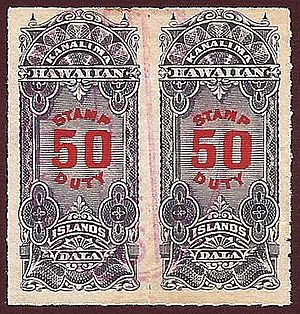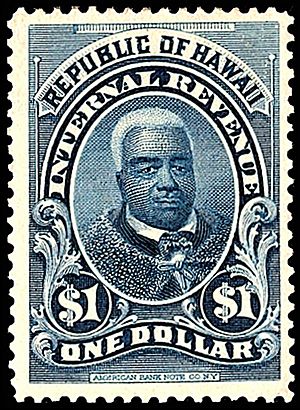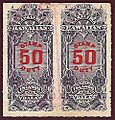Revenue stamps of Hawaii facts for kids
Revenue stamps are special stickers or marks that show a tax has been paid on certain items or documents. The Hawaiian Islands started using these stamps a long time ago. The first ones were introduced around 1845 by the Kingdom of Hawaii. Later, in 1876, new types of revenue stamps were created to collect taxes on things like official papers.
These stamps were used for over 30 years! They were still used when Hawaii was a Kingdom, then a Provisional Government, a Republic, and even after it became a U.S. Territory. Over time, the stamps changed. Some were made with tiny holes (perforated) instead of rough edges (rouletted). New values, colors, and designs were also added. Sometimes, regular postage stamps were even used for taxes. Hawaii stopped issuing its own revenue stamps in 1917 when the main tax law changed. Today, Hawaii still uses special labels for taxes on things like cigarettes.
Contents
Early Hawaiian Revenue Stamps
Hawaii first used special embossed (raised design) revenue stamps around 1845. These stamps didn't have colors; they were just pressed into paper. Different types of these embossed stamps were used until the late 1800s.
Kingdom of Hawaii's First Stamps
The Kingdom of Hawaii's Ministry of Finance (the government department in charge of money) released its first set of colorful revenue stamps on December 22, 1876. This happened because a new law, the Stamp Duty Act of 1876, introduced taxes on documents like deeds and agreements.
The first stamps were for 25 cents and 50 cents. A $1 stamp was added in March 1877, and then $5, $10, and $50 stamps came out in March 1879. These stamps showed numbers and the word "dala" for dollars, which was the Hawaiian way of saying dollar. The stamps said "HAWAIIAN ISLANDS" and had rough edges (rouletted). They were printed in New York City by a company called American Bank Note Company. A person named J. O. Carter likely designed them.
Special Import Taxes
In 1886, Hawaii put a $1 tax on certain imported goods. At first, the $1 revenue stamp from 1877 was used for this tax. But when those ran out, a $1 postage stamp from 1883, which showed Queen Emma, was used instead. Sometimes, two 50-cent postage stamps (showing King Lunalilo) were also used. These postage stamps had special marks on them to show they were used for tax purposes. For example, some had a Maltese cross design, or the initials of the tax collector. This special import tax was stopped in 1888.
In 1892, Queen Liliʻuokalani approved a tax on playing cards. A 25-cent stamp was planned for this, but it was never actually released. The tax was canceled in 1893.
Stamps During Government Changes
Just before the Kingdom of Hawaii was overthrown in 1893, Queen Liliʻuokalani approved a change in the tax on stock certificates. The tax was lowered from 25 cents to 20 cents for every $100. This new tax rate started on April 1, 1893, when Hawaii was under the Provisional Government.
Provisional Government Stamps
The Provisional Government ordered new 20-cent stamps from a printer in San Francisco. But there was a mistake! The printer accidentally made 25-cent stamps instead, even though they looked similar to the older 1876 stamps but in a new color. The mistake was quickly noticed, and the correct 20-cent stamps were ordered. Both the correct 20-cent stamps and the mistaken 25-cent stamps were used in Hawaii. It's even possible that the 25-cent stamps were sold for 20 cents. These stamps came with or without perforations (tiny holes).
Republic of Hawaii Stamps
When Hawaii became the Republic of Hawaii, the older revenue stamps continued to be used. The $1 stamp from 1876 was even reprinted. In 1897, a brand new $1 stamp was issued. This stamp had a new design showing Hawaii's first king, Kamehameha I. It said "REPUBLIC OF HAWAII INTERNAL REVENUE" and was used for customs duties (taxes on imported goods). This stamp was also printed by the American Bank Note Company.
By April 1898, the supply of the 20-cent stamps printed in 1893 started to run low. So, older 25-cent green stamps from 1876 were overprinted (stamped on top) with the new value and the words "REPUBLIC OF HAWAII" in gold. Sometimes, mistakes happened, like the overprint being upside down or printed twice!
U.S. Territory Stamps
Hawaii became a U.S. Territory in 1898, and the new government started in 1900. This meant that U.S. federal taxes and U.S. revenue stamps were introduced. However, the Hawaiian Territorial Government could still collect its own taxes on some documents, so Hawaii's own revenue stamps were still used.
The first stamp issued by the Territory of Hawaii in 1900 was another 20-cent overprint on the old 25-cent stamp from 1876. This time, the overprint was in black and only showed the new value. There's a rare mistake where this overprint was printed upside down.
A $50 stamp was also issued in 1900. It had the same design as the very first stamps but said "TERRITORY OF HAWAII." Like the original, it was printed by the American Bank Note Company and had rough edges (rouletted). An "exempt" stamp, which said "NOT LIABLE TO DUTY," was issued later. This stamp was perforated (had tiny holes) instead of rouletted. We don't know much about this stamp, but it was used between 1910 and 1917.
The last set of revenue stamps was issued between 1909 and 1913. These stamps looked just like the first ones, with the same words and colors, but they were perforated instead of rouletted. They were also printed by the American Bank Note Company. Four values were released: $5 and $10 in 1909, and 50 cents and $1 in 1913. The $5 stamp has a very rare error where its center design is upside down. This is Hawaii's rarest revenue stamp!
All these stamps were stopped when the main tax law was canceled in 1917.
In 1905, a special tax seal was issued by the Office of the Treasurer of the Territory of Hawaii. This seal was put on containers of certain goods to show a tax had been paid. It is very rare today.
In the 1930s, the Department of Agriculture and Forestry issued a stamp that didn't show a specific value. It was used to show that a permit for growing certain plants had been paid for.
Hawaii as a U.S. State
When Hawaii became a U.S. state, new types of tax markings appeared. In 1964, a special tape was reportedly used for egg inspections. In 1967, meter stamps were introduced for a tax on property transfers.
Since 2001, special heat-transfer labels have been used to show that cigarette taxes have been paid.
Images for kids





